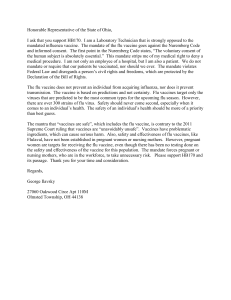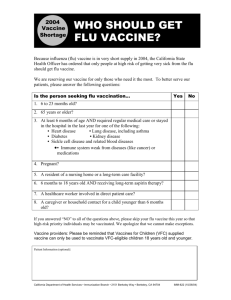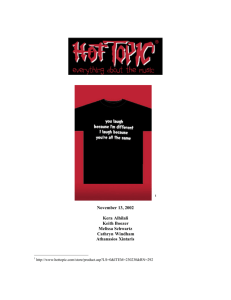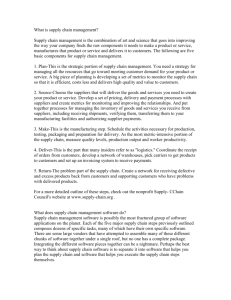Policy Recommendations for Managing the Flu Vaccine Supply
advertisement
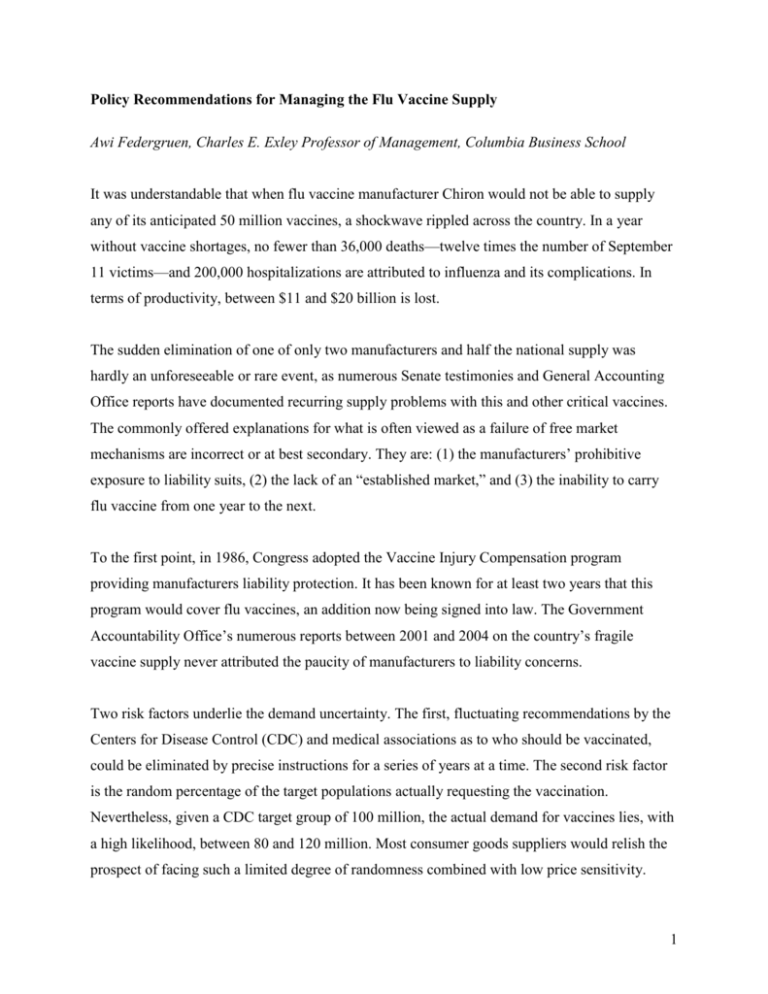
Policy Recommendations for Managing the Flu Vaccine Supply Awi Federgruen, Charles E. Exley Professor of Management, Columbia Business School It was understandable that when flu vaccine manufacturer Chiron would not be able to supply any of its anticipated 50 million vaccines, a shockwave rippled across the country. In a year without vaccine shortages, no fewer than 36,000 deaths—twelve times the number of September 11 victims—and 200,000 hospitalizations are attributed to influenza and its complications. In terms of productivity, between $11 and $20 billion is lost. The sudden elimination of one of only two manufacturers and half the national supply was hardly an unforeseeable or rare event, as numerous Senate testimonies and General Accounting Office reports have documented recurring supply problems with this and other critical vaccines. The commonly offered explanations for what is often viewed as a failure of free market mechanisms are incorrect or at best secondary. They are: (1) the manufacturers’ prohibitive exposure to liability suits, (2) the lack of an “established market,” and (3) the inability to carry flu vaccine from one year to the next. To the first point, in 1986, Congress adopted the Vaccine Injury Compensation program providing manufacturers liability protection. It has been known for at least two years that this program would cover flu vaccines, an addition now being signed into law. The Government Accountability Office’s numerous reports between 2001 and 2004 on the country’s fragile vaccine supply never attributed the paucity of manufacturers to liability concerns. Two risk factors underlie the demand uncertainty. The first, fluctuating recommendations by the Centers for Disease Control (CDC) and medical associations as to who should be vaccinated, could be eliminated by precise instructions for a series of years at a time. The second risk factor is the random percentage of the target populations actually requesting the vaccination. Nevertheless, given a CDC target group of 100 million, the actual demand for vaccines lies, with a high likelihood, between 80 and 120 million. Most consumer goods suppliers would relish the prospect of facing such a limited degree of randomness combined with low price sensitivity. 1 Finally, many consumer goods industries dealing with perishable or fashion items need to discard unsold goods. Far from being driven out of the market, they determine appropriate safety stocks and incorporate the cost into the item price. What then explains the paucity of suppliers? An upfront investment in a production facility, conforming to FDA regulations, of between $500 million and $1 billion, constitutes a formidable barrier to market entry, in particular under limited visibility regarding the target population. Some conclude that, to avert future crises, the government needs to run its own production facilities or be the sole distributor. I disagree. Instead, the government and the private sector should each do what it does best. The government can create an incentive structure to entice pharmaceuticals to enter the market, while providing the oversight to ensure, with a very high likelihood, that aggregate supply covers total demand. To this end, a yearly target supply level can be determined along with a desired number of suppliers. My analysis indicates that, under reasonable assumptions regarding the likelihood of production failures and the degree of demand uncertainty, we are indeed irresponsibly vulnerable when dependent on two suppliers. However, spreading the supply over four or five suppliers almost invariably meets the objective and this with a moderate safety stock. For example, when 100 million vaccinations are expected, we may need an aggregate attempted supply of 140 million, spread over four suppliers, with the possibility that some facilities will fail. Continuing this example, the process would, in its simplest form, involve an auction in which all qualified suppliers could bid on a multi-year contract to provide a pre-specified annual volume; the four lowest bidders would be selected. The contract term should be sufficient to enable companies to profitably recover fixed production costs. Suppliers continue to distribute directly to health care providers with the government agreeing to buy any unsold inventory, albeit at a price significantly below the contracted sales price so as to protect suppliers against most of the demand risk, while providing incentives for them to exert competitive sales efforts. The cost of this guarantee is dwarfed by the medical and productivity costs of unprevented influenza cases. 2 Auctions of this type, referred to as reverse procurement auctions, are commonplace in the private sector, sometimes facilitated by dedicated exchanges supporting a range of auction formats. Similarly, buyback agreements are frequently used to mitigate demand uncertainty. The above should be complemented with efforts to expand the target population, further reducing deaths, hospitalizations and productivity losses, while shortening the manufacturers’ payback times. With these mechanisms in place, we can yet look forward to a shot in the arm for all. 3

